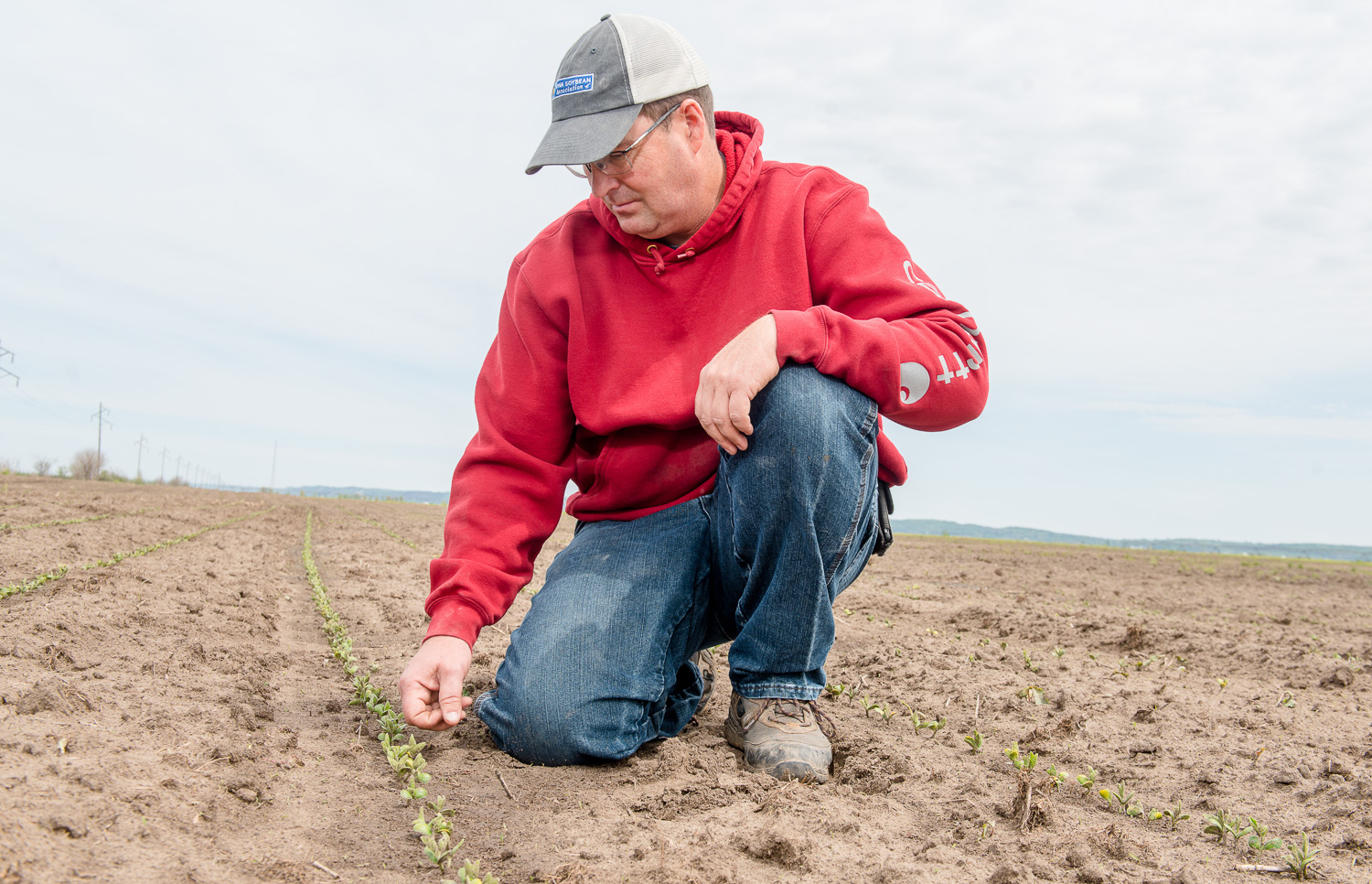
Jeff Jorgenson checks the progress of his soybeans last spring at his Fremont County farm. Jorgenson and other ISA directors participated in a virtual Mexico trade mission last week. (Photo: Joseph L. Murphy/Iowa Soybean Association)
Mexican customers reaffirm preference for U.S. soy
March 18, 2021 | Bethany Baratta
Continued demand for soybeans in Mexico is good for Iowa soybean farmers; a projected large soybean crop in Iowa is good for Mexican buyers.
And every day that passes is one day closer to planting another soybean crop, says Iowa Soybean Association (ISA) President Jeff Jorgenson.
“Iowa farmers are going to be ready to produce a crop, I’ll promise you that,” Jorgenson told buyers during a recent virtual visit between Iowa soybean farmers and their second largest soybean customer: Mexico.
The Iowa Virtual Trade Mission to Mexico was hosted by the U.S. Soybean Export Council (USSEC), the American Soybean Association (ASA), the United Soybean Board, ISA, and Iowa Economic Development Authority.
Mexico purchases
Mexico is collectively the second largest global customer for soybeans and soybean meal.
The United States exports $1.3 billion in ag products to Mexico. Soybean exports make up 19% of that total, according to Brad Frisvold, marketing manager for the international trade office for the Iowa Economic Development Authority.
Reliability, consistency
Arturo Basulto, purchasing manager for firm of 10 Mexican grain purchasers, says his group relies on the United States for its soybean, soybean meal and corn needs.
“In southern Mexico we don’t produce any grains. We depend completely on imports of grains and oilseeds from the U.S. For us, importing corn and soy from the U.S. has been the key to our success,” Basulto said.
Based in Merida, Yucatan, the purchasing pool groups 10 animal feed and livestock producers and commercial and integrated firms established in southeastern Mexico. He said the availability of U.S. soybeans and corn year-round make the United States a reliable supplier of products they need. That’s not the case from other origins.
“That’s been the key for growth of our industry and self-sufficiency of meat and eggs in south-southeast Mexico,” Basulto said. “That wouldn’t have been possible without the ensured supply.”
He said the group values the collaboration with USSEC and the technical and trade assistance activities provided from throughout the U.S. soy industry. Assistance ranging from purchasing practices and management to animal nutrition and feed and soybean meal processing has been beneficial, he said.
Soy processing
“It makes us feel proud to have soy that comes from Iowa here in our country,” said Amadeo Ibarra, general of the National Association of Edible Oils & Shortening Producers which represents the Mexican edible oils, fats, and meals sector.
Mexico ranks eighth in the world in soybean processing and soybean oil production. Soybeans account for 70% of the total volume of oilseeds processed in Mexico. Soybean oil has a 34% market share in the edible oils and fats sector in Mexico.
It is the ninth largest producer of soybean meal in the country. Soybean meal represents 64% of the country’s protein meals.
Mexico was one self-sufficient in the production of oilseeds, including soy oil, until the late 1980s. But ag policies, phytosanitary problems and other factors reduced oilseed production. Now, palm oil, olive oil, and avocado oil production is ramping up. Therefore, Mexico relies on the United States for its soybean needs for soybean meal and soy oil processing.
Sustainability
U.S. Soy’s sustainability messaging is resonating with Mexican customers, Basulto says. Since 2017 all soybean shipments from the United States have certificates of sustainability.
“We let the consumer know about the origin of this (soy) ingredient because this … has such prestige and creates confidence in our consumers,” Basulto said.
Advancements in technology has propelled Iowa farmers to grow their crops more sustainably, ISA District 4 Director Jeff Frank said.
“I’ve been farming more than 40 years and I’ve seen lot of changes in how we do things and take care of land. Didn’t used to do no-till and hardly any minim till—this was all conventional (till) when I was young,” Frank said. “It’s changed a lot of things to make our crops more sustainable.”
He noted conservation efforts on his farm near Auburn and across the state combined with technological advancements that pinpoint soil and crop needs.
“Everything is geared into putting the right seed, fertilizer, manure at the right place and right time. All of that makes a difference to make us more profitable, too,” Frank said.
“We’re trying to do what’s right for water quality,” said Robb Ewoldt, ISA president-elect near Davenport. “Using soil sampling and other technology, we can pinpoint where we want to put that fertilizer. As a result, we’ve cut fertilizer use to about one-third. That’s a win for farmers economically and a win for the environment because we’re using less fertilizer and still seeing our yields go up.”
Back